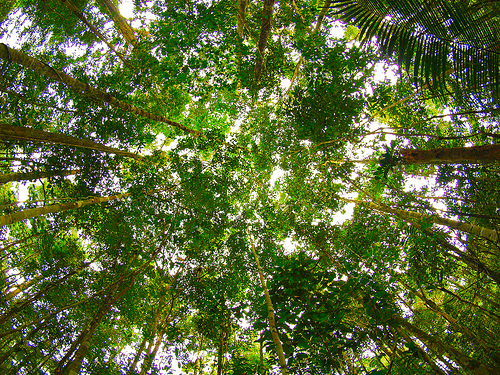The tiny, diligent gardeners of the Amazon
The gardeners described here are not concerned with trimmed topiaries or manicured lawns—though, like designers of landscape gardens, these workers are exceptionally picky. And they have to be if they are going to survive. That is, ants such as Myrmelachista schumanni and Camponotus femoratus of South America depend on certain plants for shelter, and in return, they offer these plants nutrients and protection from predators. As a result, they have developed a mutualistic relationship that has led to an incredible resilience for both species.
For example, the ant M. schumanni has kept the plant Duroia hirsute alive in one area of the Amazon, known as a devil’s garden to locals, for more than 800 years. This particular type of ant-plant dependency is plentiful in the Amazon and it creates eerie patches of monoculture gardens amidst the rest of the lush, diverse rainforest. As biologist and photographer Alex Wild described in a recent Myrmecos blog post (complete with photos):
I had been following an army ant raid for half an hour through dense tropical forest when the trees unexpectedly parted to reveal a small clearing. Sun broke through the canopy and fell on a low tangle of furry plants. It was a monoculture, looking as though planted by a reclusive sort of gardener.
I had stumbled into a Devil’s Garden.
Local lore holds that malevolent forest spirits create these unnatural crop circles, but the truth is just as weird. Devil’s Gardens are [cultivated] by ants.
The plant species that compose these gardens—mostly in the genera Tococa, Clidemia, and Duroia—sport swollen structures filled by the nests of tiny Myrmelachista ants no more than 3 millimeters long. The ants are meticulous about caring for their hosts, removing [pesky] herbivores and injecting formic acid into the saplings of competing plants.
Another ant species, C. femoratus, gathers the seeds of particular plants to cultivate in its nests, called ant gardens, and made of a mixture of animal feces, digested plants and other organic material. These nests are attached to vines, the sides of trees and even high up in the tree canopy. As Elsa Youngsteadt explained in the podcast Curiouser and Curiouser, ants followed chemical signals given off by seeds of certain plants, collected the seeds, carried them back and embedded them in the walls of the nests. The plants benefitted from the fertilizer mixed in the nest, and in turn, the roots helped to add structure to the ant garden. In addition, the leaves protected it from heavy rains that would otherwise have caused the material to disintegrate.
“There are about ten plant species that are in ant gardens regularly that you don’t find growing anywhere else,” said Youngsteadt as she described her research in the podcast, “and not only that, these ant-garden ants collect seeds other ants don’t. I set the seeds out at little bait stations throughout the forest and hardly any other ants would pick them up at all—they’re sort of garbage to other species but really attractive to the ant garden species.”
Read more at “Symbiotic Nitrogen Fixation in the Fungus Gardens of Leaf-Cutter Ants” in Science and “Small Matters” in Smithsonian. Also, see the below PBS video on the life of ant expert E.O. Wilson.
Photo Credit: Alexander Torrenegra
